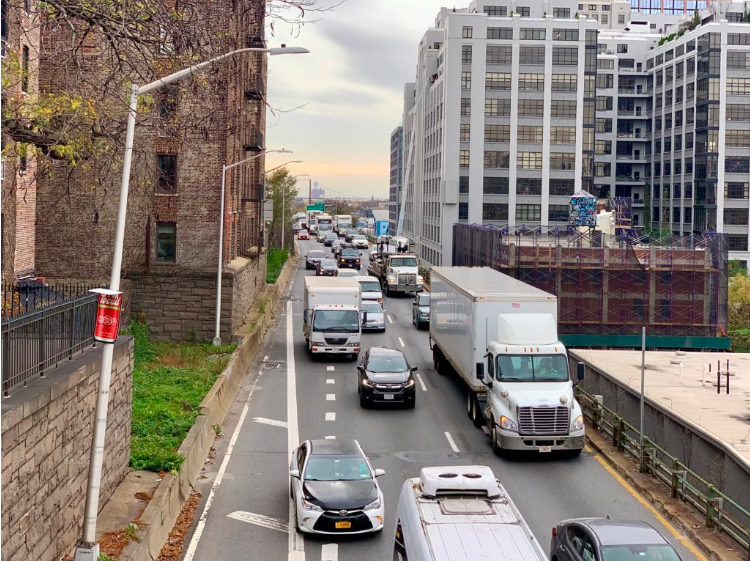Brooklyn officials frustrated; expected technology in January
From brooklyneagle.com
A highly anticipated project designed to electronically ticket overweight trucks on the Brooklyn- Queens-Expressway (BQE) will be “significantly delayed,” the city Department of Transportation has told Brooklyn officials.
The goal of the BQE Weigh-In-Motion (WIM) system is to prevent massive trucks from further deteriorating the triple cantilever that underpins the Brooklyn Heights Promenade.
Local officials said they were deeply disappointed by the news.
“After a year of anticipating a January 2023 roll out of WIM, and being told by DOT that the program was on schedule, we were just informed that DOT has not yet completed the sensor installation,” officials said in a statement issued Wednesday. “Even more troubling is that DOT also just informed us that federal calibration standards do not yet encompass the new technology that WIM uses, thus significantly de- laying the WIM implementation until such an adjustment can be made.”
Signing the statement were Assemblymember Jo Anne Simon, state Sen. Brian Kavanagh, Rep. Dan Goldman, Rep. Nydia Velázquez, state Sen. Andrew Gounardes and Councilmember Lincoln Restler.
“NYC DOT needs to expeditiously work to get WIM in place, and immediately accelerate investments to preserve this faltering structure before it is too late,” the group urged. “This includes safety and remedial measures that the city committed to taking, but has since postponed, such as waterproofing roadway joints on the cantilever.”
They added, “As we embark on what will undoubtedly be a long and complicated process to improve and re-imagine the entire BQE corridor, we want the public to know that we are deeply concerned about this delay, and we are doing everything we can to keep communities safe.”
DOT: It’s the calibration protocols
NYC DOT spokes- person Vincent Barone told the Brooklyn Eagle on Wednesday that motion sensors have been installed; it’s the calibration protocols which are still in development.
He reassured the Eagle that the DOT is fully engaged in maintaining the safety of the BQE.
“As the Adams administration develops concepts for a long-term fix for BQE Central, DOT is rigorously monitoring the triple cantilever and making interim repairs as needed to ensure it remains structu- rally sound,” Barone said.
“We have installed weigh-in-motion sensors along BQE Central and are working through remaining internal and external administrative processes to launch what will be a first-in-the-nation enforcement program against overweight trucks,” he said.
Simon: Led to believe it would be ready in January
In December 2021, Simon and Kavanagh, at the request of NYC Department of Transportation, secured the passage of the WIM legislation (S2740B/A2316). The system will target trucks exceeding the 40-ton weight limit while traveling along the Brooklyn Central portion of the BQE, which runs from Atlantic Avenue to Sands Street.
About 11% of the trucks traveling there are overweight, a study of the highway showed. An expert panel convened by then-Mayor Bill de Blasio found that illegally overweight trucks were contributing significantly to the structure’s deterioration.
Since the WIM is the first of its type in nation, the calibration protocols aren’t quite the same as those currently in use, Simon told the Eagle. “Since it’s new — it’s a purpose-built system — we’re just a little ahead of it.”
To issue citations, the WIM has to properly calibrate weight and convert it to state systems, she said. “It’s the state Department of Motor Vehicles that issues tickets.”
She is disappointed that DOT did not keep officials abreast of the delay, however. “We were led to believe it would be working in January, and we would be able to issue violations in January. I wish we knew this months ago. “I think we all [officials] share this frustration.”
Besides having a deleterious effect on the roadway, “It’s also relevant that overweight trucks have increased emissions,” Simon said.
A ‘Highway to Hell’
Brooklyn Heights resident Laurie Garrett is a Pulitzer Prize-winning author on global public health. She pointed out years ago the dangers of the toxic particulate matter released by the more-than- 150,000 trucks and cars that travel the BQE daily.
“The most optimistic engineering forecasts put key parts of the BQE, especially cantilevered sections in Brooklyn, in danger of collapse or structural failure by 2026, but there is no “Big Fix” plan,” Garrett told the Eagle on Wednesday.
“There are only two ways — ideally in combination — to genuinely delay catastrophic events: Close down lanes, and/or enforce strict weight limits on all vehicles” Garrett said. “Without weight sensors, there can be no enforcement, and loaded trucks weighing 10 times the burdens of loaded vehicles 80 years ago will continue roaring down a highway to hell.”
NYCDOT unveiled its first draft of design possibilities for the reconstruction of BQE Central in mid-December. “Now is the time to think big,” Mayor Eric Adams said at that time. Brooklyn officials thought the city could do better, however. Public workshops have been ongoing.
Adams and his DOT Commissioner Ydanis Rodriguez are accelerating the redesign timetable to take advantage of President Biden’s Bipartisan Infrastructure Law.

 MTA celebrates 95th Street station’s new elevators
MTA celebrates 95th Street station’s new elevators  Cops arrest man in fatal hit-and-run in Bensonhurst
Cops arrest man in fatal hit-and-run in Bensonhurst